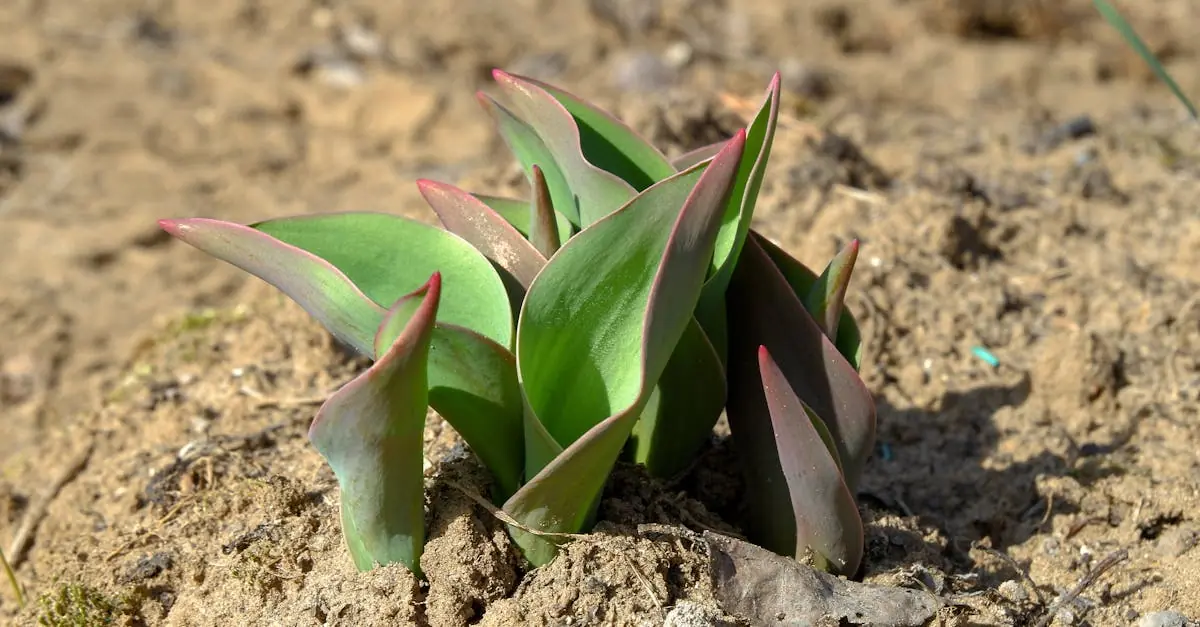Table of Contents
ToggleImagine stepping into your backyard and being greeted by a vibrant oasis of colors, scents, and flavors. Starting a garden isn’t just a way to impress your friends; it’s a ticket to fresh produce and a little slice of nature right outside your door. Plus, who wouldn’t want to become the proud parent of a tomato plant that’s actually thriving?
Understanding Your Gardening Space
Knowing your gardening space plays a crucial role in a successful garden. Assess different aspects of the backyard to determine what plants thrive best.
Assessing Your Backyard
Evaluate the available space. Measure the area you plan to use for gardening. Consider the proximity to water sources for irrigation. Identify any obstacles like tree roots or structures that may block sunlight. Observe the layout of the garden with respect to accessibility for maintenance. Note the aesthetic appeal and how it integrates with your overall outdoor design.
Sunlight and Soil Considerations
Examine sunlight exposure. Identify areas with full sun, partial shade, and full shade throughout the day. Most vegetables and flowers require at least six hours of direct sunlight daily. Test the soil quality by checking its texture and nutrient levels. Conduct a soil test to determine pH and organic matter content. Amend the soil as needed to create an optimal growing environment, enhancing fertility and drainage for healthy plants.
Choosing the Right Plants
Selecting the right plants is essential for a successful garden. Growers must consider various factors, including climate, space, and personal preferences.
Vegetables vs. Flowers
Vegetables provide a practical approach, offering fresh produce everyone appreciates. Specific options include tomatoes, peppers, and carrots, which thrive in many climates. Flowers brighten the garden and attract beneficial insects. Consider sunflowers, marigolds, and zinnias for vibrant color and pollinator support. Gardeners can focus on a mixed planting strategy, combining both vegetables and flowers. This method maximizes space and enhances biodiversity.
Native Plants and Their Benefits
Native plants adapt well to local conditions, ensuring better growth without excessive maintenance. They require less water and resist pests naturally, making them eco-friendly choices. Incorporating species like milkweed or coneflower supports local wildlife and pollinators. These plants also contribute to soil health, benefiting the overall garden. Selecting natives fosters a sustainable garden that harmonizes with the surrounding environment, promoting biodiversity and resilience.
Essential Gardening Tools
Having the right tools makes starting a garden much easier. Equipped with essential gardening tools, gardeners tackle various tasks effectively.
Basic Tools for Beginners
Shovels serve as the first must-have tool. They aid in digging and moving soil. Trowels complement shovels, perfect for planting seeds and transplanting small plants. Gloves protect hands from thorns and dirt while working in the garden. Watering cans allow for targeted watering, essential for keeping plants hydrated. Rakes smooth soil surfaces and help remove debris. Garden forks mix compost into the soil and break up tough clumps, ensuring a well-prepared planting bed. Securing these basic tools sets beginners up for success in their gardening journey.
Advanced Tools for Serious Gardeners
Serious gardeners often turn to more specialized tools. Cultivators loosen soil and help aerate it, promoting root health for established plants. Pruning shears become invaluable for maintaining plant shape and encouraging growth. Soil testers provide essential insights into nutrient levels, guiding gardeners in amendments for optimal health. Garden carts facilitate easy transport of soil, tools, and plants, saving time and effort. Landscape fabric ensures weed control while allowing water and nutrients to reach plant roots. With advanced tools, seasoned gardeners enhance their productivity and elevate their gardening experience.
Preparing Your Garden Bed
Preparing a garden bed lays the foundation for a thriving garden. Focus on soil quality, structure, and plant compatibility for successful growth.
Soil Preparation Techniques
Soil preparation starts with testing for pH and nutrient levels. Amending the soil with organic matter, such as compost, enriches its structure and fertility. Tilling the soil loosens it, improving drainage and aeration for plant roots. Incorporating mulch reduces weeds and retains soil moisture. Mixing in soil enhancers like bone meal or blood meal boosts nutrient content for healthy plants. Regularly monitoring soil conditions maintains an optimal growing environment.
Raised Beds vs. In-Ground Gardens
Raised beds offer distinct advantages, including improved drainage and warm soil temperatures. They can reduce soil compaction and provide easier access for planting and maintenance. In-ground gardens require thorough soil preparation and are often less costly. However, they can face challenges like poor drainage and accessibility. A combination of both methods can maximize growing space and diversify plant options. Evaluate personal preferences when choosing between raised or in-ground gardening to create the ideal garden layout.
Planting Techniques
Understanding planting techniques ensures successful growth in a backyard garden. Various methods help cater to specific needs and preferences.
Seed Starting Indoors
Starting seeds indoors promotes early growth and healthier plants. Choose seed trays or small pots filled with seed-starting mix. Lightly water the soil and place the seeds according to packet instructions. Keep trays in a warm, bright location or use grow lights to maintain adequate light. Monitor moisture levels, avoiding over-saturation. Transplant seedlings outdoors once they grow two sets of true leaves and after the last frost date. Seed starting indoors gives plants a head start, maximizing potential yield.
Direct Seeding vs. Transplants
Direct seeding simplifies planting as seeds enter the ground where they’ll grow. Consider this method for fast-growing crops like radishes and lettuce. Planting seeds directly saves time and encourages strong root systems. Transplants involve starting seeds indoors or purchasing young plants. This option suits crops like tomatoes and peppers, which require longer growing seasons. Transplants typically yield earlier harvests and can adapt better to the garden’s specific conditions. Choose the method that best aligns with garden goals and plant preferences for optimal results.
Maintenance and Care
Maintaining a garden involves regular attention and care to ensure healthy plant growth. Proper practices contribute to a thriving backyard sanctuary.
Watering Practices
Watering plays a crucial role in plant health. Assess the moisture level in the soil before watering. An inch of water per week, including rainfall, works well for most garden plants. Early morning is the best time for watering, as it allows the soil to absorb moisture before the heat of the day. Drip irrigation systems can help conserve water while delivering it directly to the plant roots. Adjust watering frequency based on seasonal needs, ensuring plants remain hydrated without overwatering.
Pest Control Methods
Managing pests protects plants from damage. Regularly inspect plants for signs of pests like aphids or spider mites. Natural remedies include introducing beneficial insects such as ladybugs. Neem oil and insecticidal soap also offer effective, organic solutions. Crop rotation can reduce pest populations by varying plant families in specific areas each season. Maintaining healthy soil through composting and mulching strengthens plants, making them more resilient against pests.
Starting a garden in the backyard can transform outdoor spaces into vibrant ecosystems. With the right tools and techniques anyone can cultivate a flourishing garden that not only produces fresh food but also enhances the beauty of their surroundings. By understanding the specific needs of plants and preparing the soil properly gardeners set the stage for success.
Regular maintenance and smart planting strategies ensure that gardens thrive throughout the seasons. Embracing this rewarding hobby fosters a deeper connection with nature while offering a sense of accomplishment. Whether growing vegetables or flowers the journey of gardening is filled with discovery and joy.





